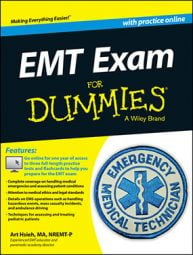You should be familiar with cardiovascular pump problems for the EMT exam. In order to work effectively, the heart has to have good blood flow to its muscle via its coronary arteries and an intact electrical system that controls the rate, strength, and timing of the contractions between the atria and ventricles. Check out this list of the most common heart conditions.
| Problem | Signs and Symptoms | Action Steps |
|---|---|---|
| Acute coronary syndrome | Beware of women, diabetics, and older patients having unusual signs such as shortness of breath, sudden weakness, or syncope, or no signs at all other than unexplained diaphoresis. | Find position of comfort; evaluate need for oxygen and administer supplemental O2 as needed to maintain saturation. If patient has prescribed nitroglycerin and blood pressure is above 100 mm Hg systolic, assist with medication. If authorized, administer aspirin. |
| Rhythm disturbances: Too fast, too slow, or too irregular | Rates that are too fast or too slow can cause blood pressure to
decrease. Radial pulses become difficult to find. Patient may
experience chest pain, shortness of breath, or nausea. You may find
a pacemaker or an implanted defibrillator under the skin, either in
the chest or abdominal area. Irregular heartbeat may also cause blood pressure issues or a lethal rhythm disturbance. |
Find position of comfort. Provide oxygen as needed to maintain adequate saturation. Keep an automated external defibrillator (AED) nearby and ready for use if patient loses consciousness and pulse. Note any signs of a pacemaker or implanted defibrillator. If patient becomes pulseless, place AED pads at least 1 inch away from pacemaker or implanted defibrillator. |
| Lethal rhythm disturbances | Ventricular fibrillation or ventricular tachycardia that doesn't generate a pulse. Patient is unconscious, apneic, or has gasping respirations; skin is cyanotic, cool, or diaphoretic. | High-quality CPR with at least a 2-inch compression depth and a rate of at least 100 beats per minute. If witnessed, apply AED and follow prompts. Ventilate at a ratio of 2 breaths per 30 compressions. |
| Cardiogenic shock | Poor cardiac output due to AMI or other condition. Hypotension; cool, pale, and diaphoretic skin; may have chest pain associated with poor perfusion. | Lay patient supine if possible; treat for shock by maintaining body temperature and oxygen saturation. |
| Congestive heart failure (CHF) | Fluid from capillary beds leaking into the alveoli in the lungs due to too-high or too-low pressure. May auscultate crackles or wheezes in lung fields. May have pedal edema from long-term CHF. If pressure is too high, may have jugular venous distension (JVD). May complain of chest pain or shortness of breath. | If blood pressure is high, place patient in full sitting position with feet dangling if possible. Apply oxygen to maintain adequate saturation levels. Ventilate if patient is breathing inadequately. If patient is in severe respiratory distress and conscious, apply continuous positive airway pressure (CPAP). |
It is a warm, humid morning. A 78-year-old woman is attending services at her church when she faints. Church members help her to the floor. She is awake and confused as to the day and time. Her skin is cool, pale, and diaphoretic. She has a blood pressure of 82/50 mm Hg, a heart rate of 100, and a respiratory rate of 20 breaths per minute.
She doesn't have any complaints of pain or discomfort and wants to sit up. Which of the following actions is most appropriate?
(A)Assist her to a chair and perform a secondary assessment.
(B)Provide cool compresses to reduce her body temperature.
(C)Provide spinal precautions and transport to an emergency department.
(D)Place her supine on the gurney and transport to an emergency department.
The correct answer is Choice (D). Syncope, or fainting, may be caused by a variety of medical conditions. However, in this case the most serious possibility is an acute myocardial infarction, making Choice (D) the best option.
The information doesn't suggest that she is experiencing heat stroke, as Choice (B) implies, nor is there any indication that she may have injured her spine to warrant Choice (C). With her blood pressure low, sitting, Choice (A), may cause her to faint again.

